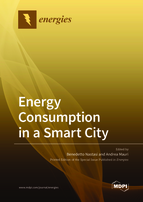Energy Consumption in a Smart City
A special issue of Energies (ISSN 1996-1073). This special issue belongs to the section "G1: Smart Cities and Urban Management".
Deadline for manuscript submissions: closed (30 June 2022) | Viewed by 36887
Special Issue Editors
2. Quantia Consulting, 22066 Mariano Comense, Italy
Interests: data science; web engineering; applied machine learning; human-centered artificial intelligence; human-computation
Interests: building physics; building services engineering; building simulation; renewable energy technologies; indoor environmental quality; open data & energy analytics; energy efficiency; zero energy buildings; power-to-X solutions; buildings, district and national energy systems
Special Issues, Collections and Topics in MDPI journals
Special Issue Information
Dear Colleagues,
Urban areas account for ~80% of world energy consumption. For this reason, to achieve Europe's 2030 Energy Strategy target of a 40% cut in greenhouse gas emissions compared to 1990 levels and at least 35.5% improvement in energy efficiency, it is crucial to reduce the energy impact of cities. To do so, it is necessary to involve all the stakeholders: energy providers, policymakers in the municipality, facility managers, and the citizens themselves, as energy consumption is influenced by this interconnected network of actors. Citizens need to be incentivized or educated to adopt a more sustainable lifestyle, policymakers require detailed information about the city to develop better policies, facility managers would benefit from data about the usage of buildings, and finally, energy providers could optimize the supply of energy to reduce waste.
A Smart City is the perfect environment to study and exploit the interactions between those actors because its architecture already integrates elements to collect data and connect to the citizens. Furthermore, the proliferation of Web platforms (e.g., social media, Web fora) and the increased affordability of sensors and IoT devices (e.g., smart meters) make data related to a large and diverse set of users accessible, as their activities in the digital world reflect their real-life actions. These new technologies can be of great use for the stakeholders as, on one hand, it provides them with semantically rich inputs and frequent updates at a relatively cheap cost and, on the other, it allows them to have a direct channel of communication with the citizens.
To fully exploit these new data sources, we need both novel computational methods (e.g., AI, data mining algorithms, knowledge representation) that are suitable for analyzing and understanding the dynamic behind energy consumption, but also a deeper understanding of how these methods can be integrated into the existing design and decision processes (e.g., human-in-the-loop processes).
Therefore, this Special Issue welcomes original multidisciplinary research works about AI, data science methods, and their integration with existing design/decision-making processes in the domain of energy consumption in a Smart City.
Topics of interest include but are not limited to:
- New data sources for energy consumption modeling in a Smart City;
- Novel computational methods and applications to support data-driven energy planning and policymaking in a Smart City;
- Tools and applications to engage with the citizen to either raise awareness on energy consumption or involve them in the decision-making process;
- Use cases;
- Smart architecture of the energy systems.
Dr. Andrea Mauri
Dr. Benedetto Nastasi
Guest Editors
Manuscript Submission Information
Manuscripts should be submitted online at www.mdpi.com by registering and logging in to this website. Once you are registered, click here to go to the submission form. Manuscripts can be submitted until the deadline. All submissions that pass pre-check are peer-reviewed. Accepted papers will be published continuously in the journal (as soon as accepted) and will be listed together on the special issue website. Research articles, review articles as well as short communications are invited. For planned papers, a title and short abstract (about 100 words) can be sent to the Editorial Office for announcement on this website.
Submitted manuscripts should not have been published previously, nor be under consideration for publication elsewhere (except conference proceedings papers). All manuscripts are thoroughly refereed through a single-blind peer-review process. A guide for authors and other relevant information for submission of manuscripts is available on the Instructions for Authors page. Energies is an international peer-reviewed open access semimonthly journal published by MDPI.
Please visit the Instructions for Authors page before submitting a manuscript. The Article Processing Charge (APC) for publication in this open access journal is 2600 CHF (Swiss Francs). Submitted papers should be well formatted and use good English. Authors may use MDPI's English editing service prior to publication or during author revisions.
Keywords
- smart city
- sustainable city
- data-driven policy making
- human-computation
- open data
- applied machine learning







